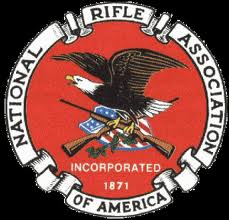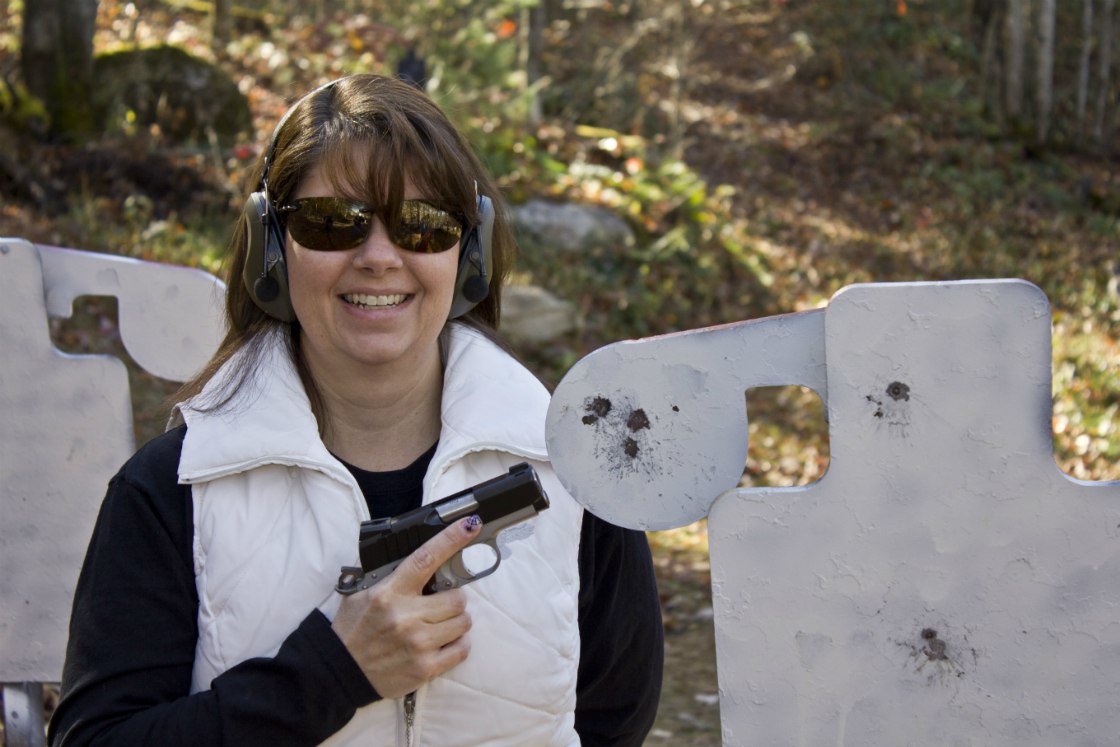Choosing a bullet trap is an important decision that will directly impact a range’s profits. However, it is a decision that often seems overwhelming given the number of options available. To truly understand how important a bullet trap is to range operations and budget, it is helpful to think of the range as a large lead processor and to answer the following eight questions:
- Will the range be limited to handguns only, or will rifles be allowed?
- What other kinds of ammunition will be used?
- How many rounds will be fired each month? Each year?
- How do you plan to collect the lead from the trap?
- What about lead dust and other airborne particles?
- What kind of budget are you working with?
- Are there any size limitations?
- What about local fire codes and other restrictions?
Once these questions are answered, it becomes much easier to choose the optimal bullet trap that aligns with the range’s goals. Luckily for range owners, Action Target provides different bullet trap choices that cater to the many possible range uses. The two most common options for commercial range use are the Total Containment Trap (TCT) and the Rubber Berm Trap (RBT). Each has obvious benefits for any range, but the difference still depends on the use of each range and the answers to the above questions.
For example, if the range’s business plan calls for a small, low-use facility, then the Rubber Berm Trap is a great option. The RBT requires a smaller footprint than the Total Containment Trap and uses a smaller amount of floor space. It takes advantage of a hassle-free design that requires very little upkeep. It utilizes the practical and beneficial properties of rubber, while eliminating weaknesses and unnecessary elements of other designs. The RBT can also be serviced from the front, whereas the TCT must be serviced from the rear. The bottom line—The Rubber Berm Trap is cheaper to build and easier to maintain.
However, if the range has a high-volume, heavy-use facility, then the Rubber Berm Trap will quickly become a frustration and a large expense. In these types of ranges, the Total Containment Trap is the optimal choice.
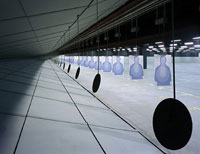 The Total Containment Trap is the dominant industry standard for modern, heavy-duty, steel bullet traps. It is the superior choice for ranges where safety, reliability, simple maintenance, and ease of use are top priorities. The TCT can be used both indoors and outdoors in all types of law enforcement, military, and commercial shooting ranges. The TCT funnels fired rounds into a deceleration chamber, which increases safety for everyone on the range. Action Target’s patented Dust Collection Unit can be installed in the Total Containment Trap, protecting the range from lead dust contamination. The bottom line: Although more expensive than the Rubber Berm Trap, the Total Containment Trap is longer lasting and better for high-use ranges.
The Total Containment Trap is the dominant industry standard for modern, heavy-duty, steel bullet traps. It is the superior choice for ranges where safety, reliability, simple maintenance, and ease of use are top priorities. The TCT can be used both indoors and outdoors in all types of law enforcement, military, and commercial shooting ranges. The TCT funnels fired rounds into a deceleration chamber, which increases safety for everyone on the range. Action Target’s patented Dust Collection Unit can be installed in the Total Containment Trap, protecting the range from lead dust contamination. The bottom line: Although more expensive than the Rubber Berm Trap, the Total Containment Trap is longer lasting and better for high-use ranges.
Before deciding on a trap, it is imperative to understand exactly what the requirements are to find the trap that supports the range goals. In today’s industry, too many owners are initially enticed by a low price only to be disappointed in the end due to the amount of unforeseen problems. For more information, Action Target has provided multiple whitepapers and a video to help choose the optimal bullet trap—visit the “Related Pages” section of our Bullet Traps page to access these resources.







 Shooting on paper is a great way to sight-in rifles and score trainings, and is great for qualifications held by law enforcement agencies. Paper allows a shooter to see where shots land, illustrating how tight groups are. The
Shooting on paper is a great way to sight-in rifles and score trainings, and is great for qualifications held by law enforcement agencies. Paper allows a shooter to see where shots land, illustrating how tight groups are. The 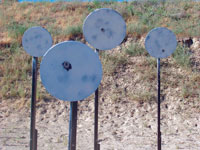 Just like in all athletic training, the body subconsciously remembers how to repeat or orchestrate all the different variables required for a successful movement, or in this case, shot. The ability that steel targets offer in regards to instantaneous feedback can actually enhance training, speed, and accuracy. This is especially important for tactical shooting scenarios with movement, such as moving plates and targets. Having multiple senses invoked during this training process conditions the shooter to become a more powerful and effective shooter.
Just like in all athletic training, the body subconsciously remembers how to repeat or orchestrate all the different variables required for a successful movement, or in this case, shot. The ability that steel targets offer in regards to instantaneous feedback can actually enhance training, speed, and accuracy. This is especially important for tactical shooting scenarios with movement, such as moving plates and targets. Having multiple senses invoked during this training process conditions the shooter to become a more powerful and effective shooter.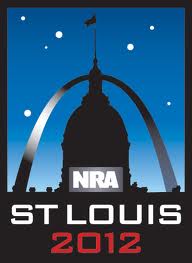 As one of the largest events among the firearms industry, all major firearms manufacturers will be in attendance. This convention provides attendees with more than 340,000 square feet of guns, gear, outfitting, and even ATV’s. The expected attendance is set at more than 70,000 with more than 40 opportunities for attendees to meet celebrities at different booths during the event.
As one of the largest events among the firearms industry, all major firearms manufacturers will be in attendance. This convention provides attendees with more than 340,000 square feet of guns, gear, outfitting, and even ATV’s. The expected attendance is set at more than 70,000 with more than 40 opportunities for attendees to meet celebrities at different booths during the event.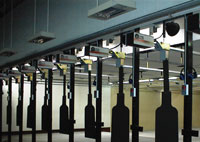 First off, it must be remembered that the range exists as the profit center to the business. Secondly, a decision needs to be made in regards to the operations of the range. In regard to the commercial value of a range, there are typically two lines of thought in the industry: one is to combine the range with the store, and the second is to not.
First off, it must be remembered that the range exists as the profit center to the business. Secondly, a decision needs to be made in regards to the operations of the range. In regard to the commercial value of a range, there are typically two lines of thought in the industry: one is to combine the range with the store, and the second is to not. The specific purpose of the Portable Target Course Book is to “ensure trainees a program that is designed to develop trainings that are safe, test fundamental skills, increase and enhance movement, improve the target selection thought processes, and enhance overall tactical awareness.” Action Target’s Portable Targets have become an industry standard and leader and the course book allows for a better overall training experience.
The specific purpose of the Portable Target Course Book is to “ensure trainees a program that is designed to develop trainings that are safe, test fundamental skills, increase and enhance movement, improve the target selection thought processes, and enhance overall tactical awareness.” Action Target’s Portable Targets have become an industry standard and leader and the course book allows for a better overall training experience. This is the same concept that is taking place when a bullet travels into the bullet trap. In front of the bullet there is a large wall of air that is being pushed into the trap. When a supersonic crack sounds, what is actually happening is that the bullet is breaking the shockwaves of air. This same air is what is being pushed in the bullet trap. If there were no dust collector on the bullet trap, the overpressure of the air entering the trap would collect surrounding particles and lead dust and shoot it back onto the range. This is where the dust collector becomes essential. The dust collector enables a negative pressure to be established inside the bullet trap, and it functions at a rate that is high enough to overcome the bullets and air pressure entering the trap. Referring again to the example of the cotton ball and the glass, if there was no back on the glass it would be easy to push the cotton ball to the rear of the glass by blowing on it. This is possible because there is no overpressure in the glass.
This is the same concept that is taking place when a bullet travels into the bullet trap. In front of the bullet there is a large wall of air that is being pushed into the trap. When a supersonic crack sounds, what is actually happening is that the bullet is breaking the shockwaves of air. This same air is what is being pushed in the bullet trap. If there were no dust collector on the bullet trap, the overpressure of the air entering the trap would collect surrounding particles and lead dust and shoot it back onto the range. This is where the dust collector becomes essential. The dust collector enables a negative pressure to be established inside the bullet trap, and it functions at a rate that is high enough to overcome the bullets and air pressure entering the trap. Referring again to the example of the cotton ball and the glass, if there was no back on the glass it would be easy to push the cotton ball to the rear of the glass by blowing on it. This is possible because there is no overpressure in the glass.